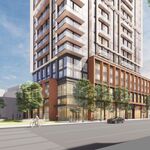One of the buildings that I found the most interesting, in the DX exhibition, was the Bai'tul Mosque in Vaughan which opened in 1992, and the residential Peace Village that surrounds it.
Zoning codes recognized churches, not mosques. Church bells and spires can exceed height limits, so the Bai'tul Mosque's builders named their dome a "church bell" to get approval. But because an open-plan mosque holds many more people in a prayer hall than a church with pews holds, it exceeds the standards of fire codes which were established for churches. So they had to argue that, in case of a fire, the open-plan wouldn't block rapid evacuation of the building as pews would.
Thus Vaughan accommodated diversity, though with church zoning standards adapted for a mosque. The logical next stage, one hopes, is for more give and take in the codes themselves - with the cultural values of new Canadians included from the start.
For instance, the exhibition raised the question of whether a mosque such as the Bai'tul actually needs that many parking spaces since the congregation lives in a development that surrounds it and are within easy walking distance. And the community itself - which consists of households based on extended families - requires larger houses: Peace Village homes range in size from 1,300 to 2,800 sq. ft. This in turn affects how Vaughan must plan for schools, libraries, hospitals etc. based on population projections. Thus is old Canada changed by new Canadian cultural values.
What I found rather odd from a cultural perspective, however, was that all the large houses in the surrounding Peace Village development that opened in 2001 were built to typical Western faux-ish designs.




